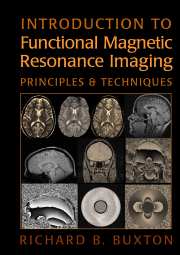
-
Select format
-
- Publisher:
- Cambridge University Press
- Publication date:
- September 2013
- January 2002
- ISBN:
- 9780511549854
- Dimensions:
- Weight & Pages:
- Dimensions:
- Weight & Pages:
You may already have access via personal or institutional login
Book description
Functional Magnetic Resonance Imaging (fMRI) is now a standard tool for mapping activation patterns in the human brain. This highly interdisciplinary field involves neuroscientists and physicists as well as clinicians, and the range, flexibility and sophistication of the techniques being used are increasing rapidly. In this book, Richard Buxton, a leading authority on fMRI, provides an invaluable introduction to how fMRI works, from basic principles and the underlying physics and physiology, to newer techniques such as arterial spin labeling and diffusion tensor imaging. The book also includes discussion of how fMRI relates to other imaging techniques (such as Positron Emission Tomography, or PET) and a guide to the statistical analysis of fMRI data. This book will be useful both to the experienced researcher using fMRI, and the clinician or researcher with no previous knowledge of the technology.
Reviews
‘… can be highly recommended to clinical researchers and all specialists in the field of functional MRI.’
Source: European Radiology
‘Buxton has an art of taking complex concepts and describing them in simple words, without oversimplifying them, using images and metaphors in a very sound way … For all of us using fMRI techniques in our research, this book is a must for our libraries. Who would have guessed that a physics textbook about fMRI could be a pleasure to read.’
Source: TRENDS in Neurosciences
' … an excellent book about MRI and its clinical applications. … covers the important points in a superb manner.'
Source: British Journal of Neurosurgery
'The chapter on statistical analysis of fMRI data guides one through this complicated method in such a way that the principles become clear. The book itself would prove very helpful to both those who are beginners in the field but also, to experienced researchers of fMRI, as a good, detailed view of the principles and techniques involved in fMRI.'
Source: Addiction Biology
Contents
Metrics
Altmetric attention score
Full text views
Full text views help Loading metrics...
Loading metrics...
* Views captured on Cambridge Core between #date#. This data will be updated every 24 hours.
Usage data cannot currently be displayed.
Accessibility standard: Unknown
Why this information is here
This section outlines the accessibility features of this content - including support for screen readers, full keyboard navigation and high-contrast display options. This may not be relevant for you.
Accessibility Information
Accessibility compliance for the PDF of this book is currently unknown and may be updated in the future.


